This review comes quite late, since the PDF of the RuneQuest Weapons & Equipment sourcebook was released in December 2021. But the print version arrived eight months later, due to the global print and shipping crisis, and my own copy was even more delayed, due to the closure of Chaosium’s Canadian warehouse. In the end, I only received the actual book a couple months ago…
This means I had quite some time to think about this book, and judge it based on my usage (or lack thereof) in my ongoing RuneQuest campaign.
Before we dive in, I want to give a big thank you to my co-host Joerg and to Austin Conrad for their thoughts, comments, and corrections!
The Book
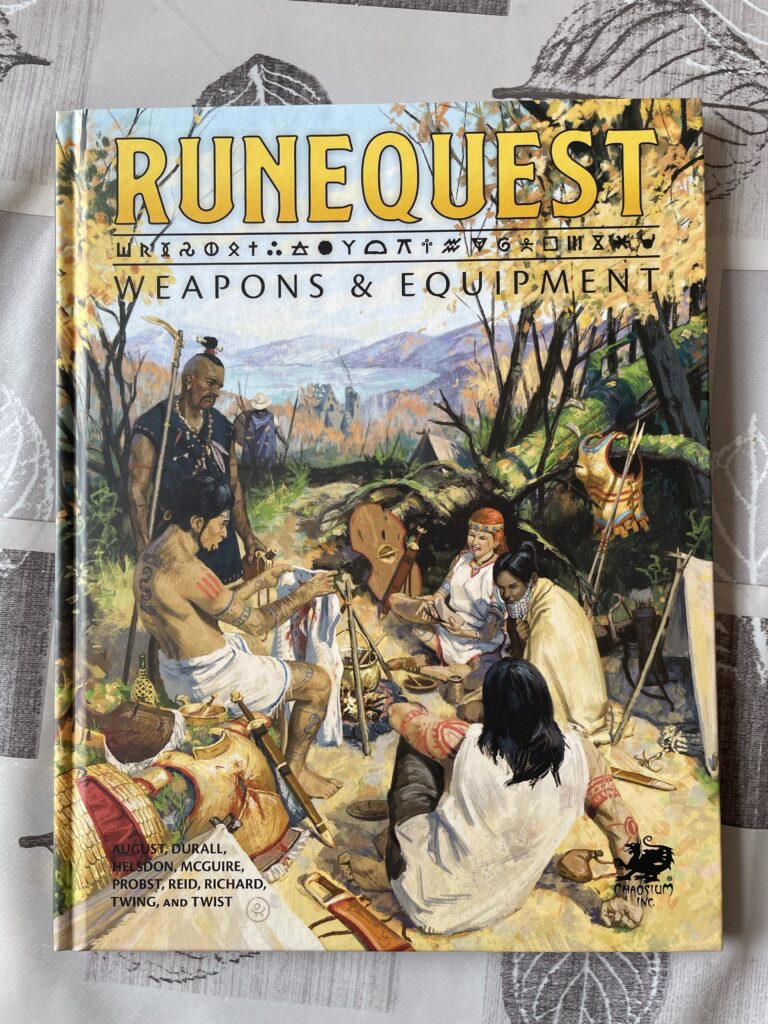
Weapons & Equipment is a 124 pages hardback with the familiar excellent layout and art of the RuneQuest Glorantha product line. When the occasional stat block shows up, it uses the newer and more compact style found in the RuneQuest Starter Set.
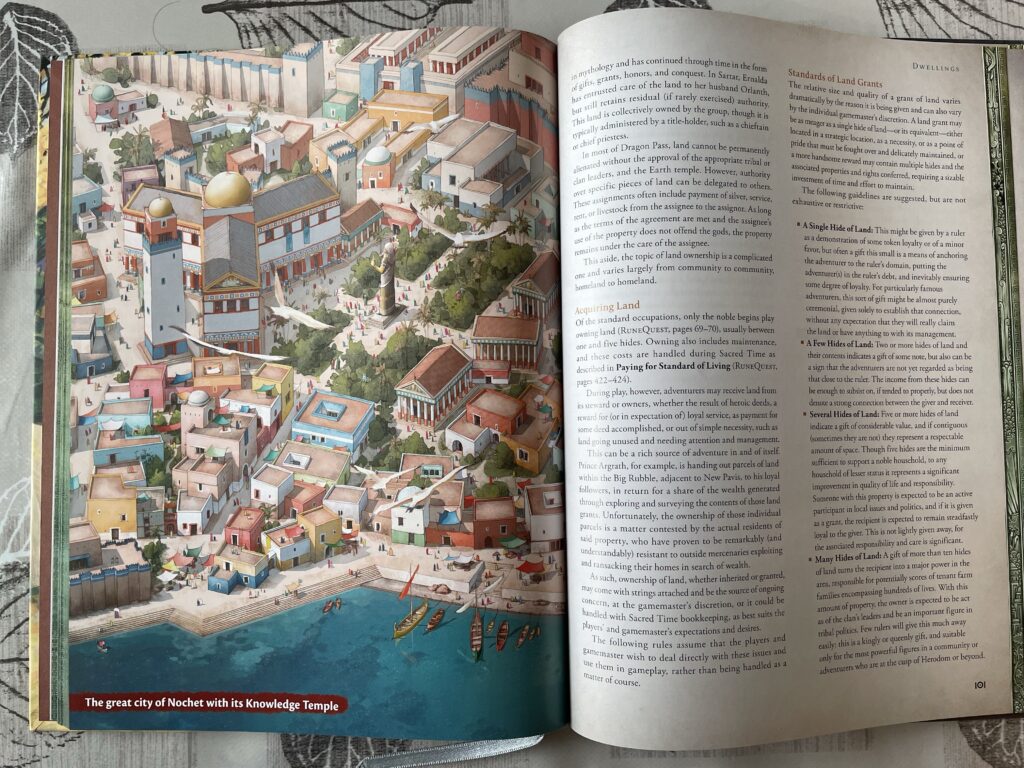
Old hands will recognize several illustrations re-used from previous publications, but most of them are great so it’s not a problem to see them again. For instance, the overview of Nochet seen above was originally from the Starter Set (ironically enough, since it doesn’t cover that part of the world), but I’m happy stumble upon it again as I flip through the book.
The new illustrations go from good to great, with nice drawings and paintings of many Gloranthan objects, weapons, and pieces of armour. The star of the book as far as I’m concerned continues to be Ossi Hiekkala, whose cover shows the likely aftermath of his equally great cover of the RuneQuest Starter Set (you can see that Harmast was likely healed from his injury, but still has to repair his shirt and armour!)
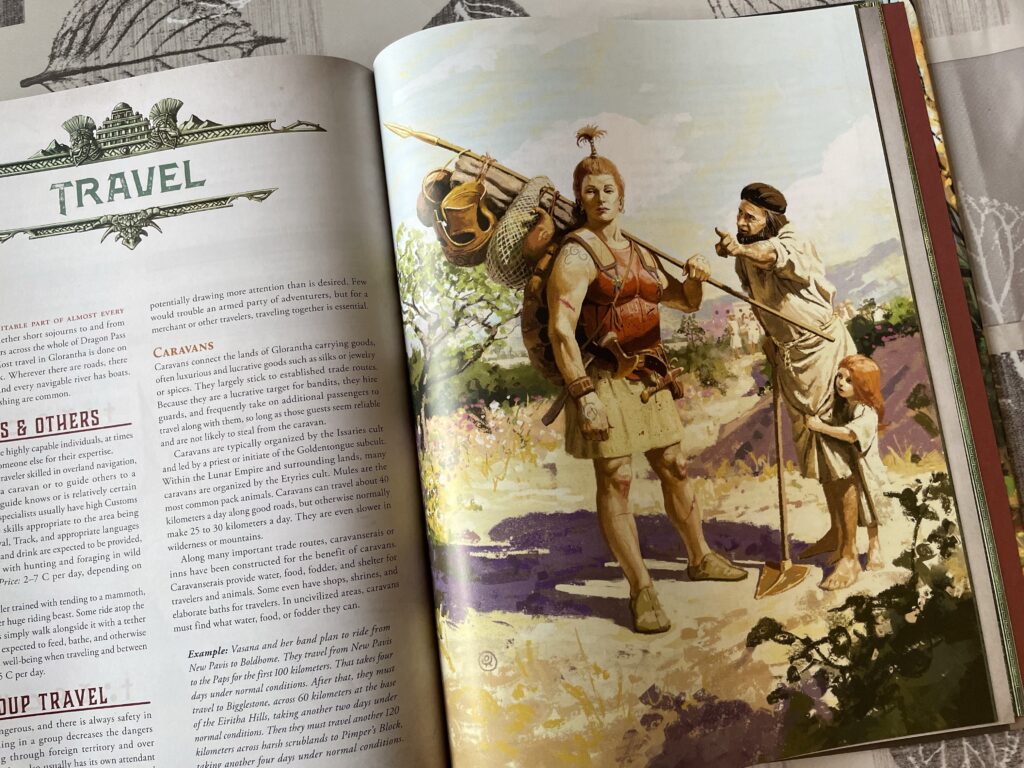
I’m absolutely delighted to see this other piece, above, that Ossi made and shared on the internet a while ago. Ossi’s style shows Glorantha as a believable place, and his mix of candid scenes, ancient world design, and stunning lighting sets RuneQuest books apart from other fantasy RPG books.
Contents
Introduction
If you’re like me, you might often skip or skim the introduction chapter of RPG books in order to “get to the good stuff”. It often proves to be a mistake, and it’s definitely the case here because a lot of the point of the book is laid out in this first pages. In particular, pay attention to the following:
[This book] can be used to flesh out one’s gear during trips to the market between adventures or during Sacred Time, or it can bolster and inspire the descriptions of items found as treasure or loot.
[…] Thus, this sourcebook is not just a catalog of things to have or to want. It is also an indispensable window into the day-to-day life of average Gloranthans, as well as into the world of exceptional adventurers, nobles, Rune Masters, and even Heroes. It teaches the world through the items and services the people own, create, or covet, whether esoteric or commonplace.
With this, it reaches beyond its utility as a mere reference work and hopefully provides a fuller, realer, and altogether more fantastic view of the Gloranthan world and its people.
If you spend enough time around archaeologists, or listening to ancient history podcasts, you quickly learn the term “material culture“, which refers to the understanding of a culture’s daily lives and experiences through its “material record”, i.e. the stuff that they leave behind, such as pottery, weapons, architecture, and so on. This is pretty much what we’re dealing with, here.
I don’t know if it was the intent of Chaosium to make the Weapons & Equipment book act partially as a presentation of the material culture of Glorantha, but I’m certain it wasn’t a coincidence that it turned out this way given the presence of archaeologists and historians, both amateur and professional, on the writing team. I’m especially thinking of Erin McGuire and Martin Helsdon, but I’m sure others contributed to this aspect of the book. Even beyond the material record, Weapons & Equipment gives us many glimpses at how Gloranthan societies work. We’ll get back to this a few times over the course of this review.
The Market
The first chapter deals with Gloranthan markets, at which your adventurers will likely buy and sell most of the stuff found in the book. Besides a few optional rules for finding and bargaining for a specific item at various markets, we get our first taste of what I was talking about earlier: some information about how those markets operate, how people pay for goods not only with coin but also with favours, letters of credit, or “hack metal”, and so on. There is a lot of gameable background information here.
Many people will in particular be interested in the “Dealing with Treasure” sidebar (which explains how most cultures split up the loot that your adventurers have brought back from their latest dungeon crawl), the “Selling Loot” section, and the section for “Maintaining and Repairing Gear”.
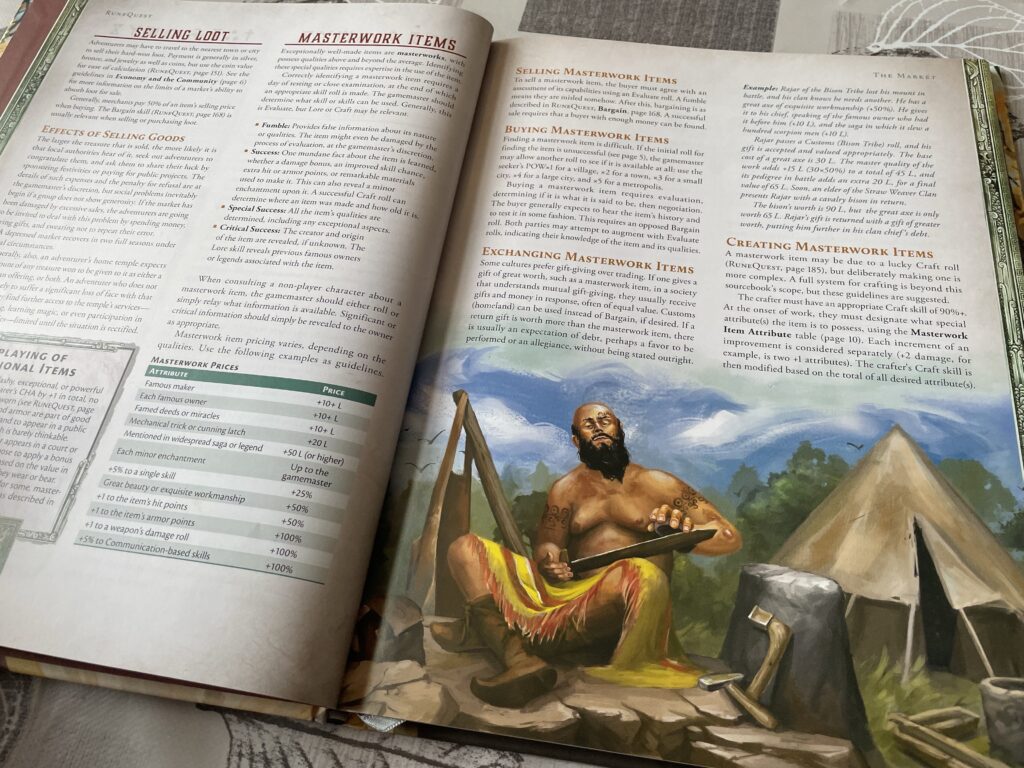
An interesting part of this chapter is the section on “Masterwork Items”. It details how crafty adventurers can create particularly good items. For instance, they could create bronze greaves with more armour points than usual, or a musical instrument that is so well crafted that it gives a bonus to the musician’s skill. I have a couple of player characters in my campaign that have a high Crafting skill and we have looked at this section once of twice for rolls or ideas. I just need to give them enough downtime to work on their items… either way, this interesting little crafting mechanic brings a welcome break from the usual combat crunch of RuneQuest.
A Bronze Age World & Common Goods
As we all know, Glorantha is “in a bronze age”, but isn’t really “a Bronze Age world”. Either way, this sort of works OK here since the next chapter starts with one of Joerg’s favourite topics: Gloranthan metallurgy.
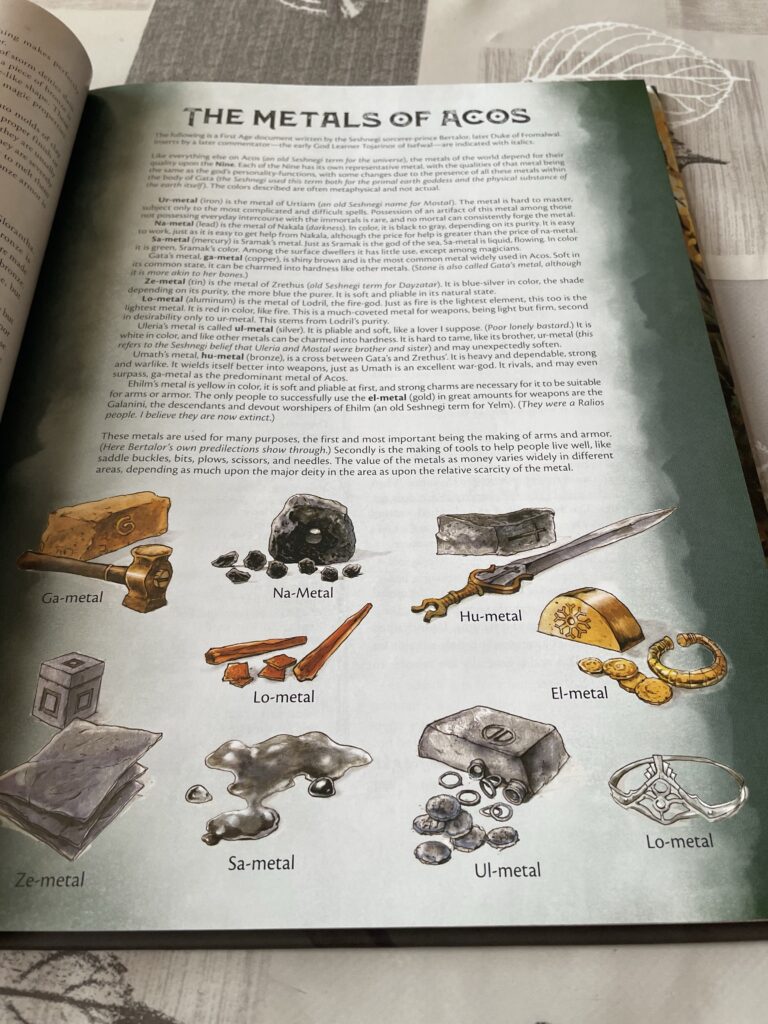
When it comes to metals, Glorantha is indeed mostly based on bronze. Never mind that most of the nobility in Sartar is clad with iron (just check the Colymar Runemaster NPCs in the Gamemaster Adventures booklet), those are a small minority. And there’s a bunch of other metals with various other properties, and various cults with the knowledge to deal with them. This section, is really a lightly expanded version of Appendix 2 from the Gamemaster Adventures, plus the “Metals of Acos” (see above) document from RuneQuest 3’s “Elder Secrets of Glorantha” (although it seems that maybe the labels under the illustrations might not be quite correct) This section does benefit a little from having more information on the spells used to enchant metals.
Next is every archaeologist’s favourite thing (besides middens): pottery! This is followed by a bit of information on looms and fuel, and then by the next chapter, “Common Goods”, which I’m throwing in the same basket. You’ve got lists of clothes, jewellery, cosmetic products, tools, musical instruments, toys, food, and much more.
This is where I’m not sure what to think. Let’s call this the Grognard/Historian dichotomy. At face value, we have about 20 pages of various things available for purchase, with their price and ENC (although which items get ENC or weight information or not seems inconsistent). But who, really, needs to know that you can buy a drinking horn for 2L, or a cooking pot for between 2C and 1L? Is anybody going to spend time in a gaming session choosing between buying a “drinking cup” versus a “parabolic cup”? Is anybody going to track the ENC of fish hooks or whistles or candles?
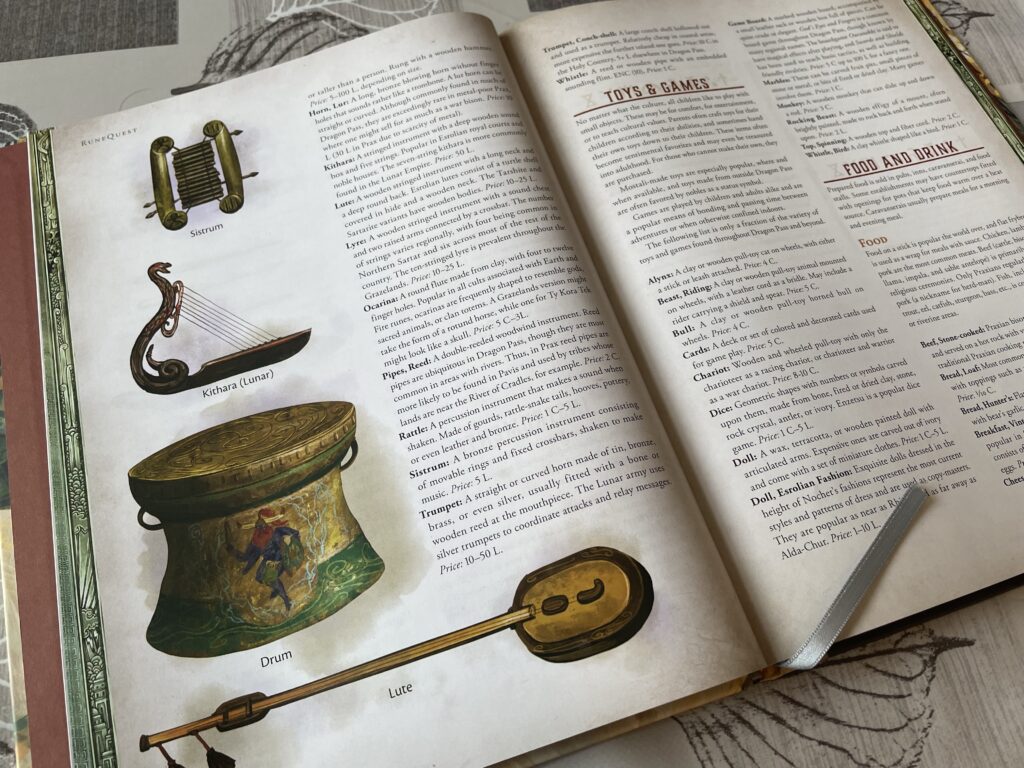
The value here is really in learning that these things exist. Saying that the adventurers are invited to a feast where “wine is flowing from amphoras into their drinking horns” sounds a lot more “ancient world” than if you say that “bottles of wine are poured into their glasses“. Mentioning that a priestess is carrying a large bowl to offer libations to an effigy of Ernalda adds that extra bit of flavour you probably want for the scene. And this is where you can learn about these things without doing historical research. I personally find value in this list of items not for their ENC stat or price point, but as tropes and bits of world-building that we can use at the table…
For example, we learn that the Lunar Heartlands have laws on who can wear what kind of clothing (based on rank and occupation), or that noble Esrolian women often leave their bodices open to let their breasts loose, Minoan-style. We learn that Etyries merchants pay extra for rubies and perfumes, as they’re very popular in the Lunar Empire. We learn that various cultures paint their faces and bodies with ash, ochre, kohl, turmeric, or more. We learn that papyrus and parchment are common, and that Esrolian flutists use metal flutes, compared to wooden flutes in Sartar and Tarsh, or bone flutes in Prax and the Grazelands. We learn the names of a few Gloranthan board games. We learn that a common street food in Nochet is skewered oysters. If you think that this all helps better depict the people and places of your game, then you’ll find a lot of value in here. If however you tend to be quite terse with your descriptions, preferring to just get on with the story, you might find all of this very tedious.
Going back to my original question, was this Chaosium’s intent here? Was the primary goal of this section (and several others later), to give a better mental picture of Glorantha, with stats and prices added “just in case”? Or was the primary goal to have a list of items to buy, and the world-building aspects emerged from having a great bunch of writers doing the work? I’m inclined to think that it’s the former… but this is where once again Chaosium sort of undersells its product, the same way they undersell their Colymar adventure book and RuneQuest handouts by calling them a “Gamemaster Screen Pack“.
Herbs, Plants, and Adventuring Gear
While the section on Herbs & Plants and Adventuring Gear are found in the Common Goods section, I want to specifically mention them because they differ a bit from what I said above.
First, the Herbs & Plants section is a complimentary version of the Flora chapter of the Glorantha Bestiary. It actually cross-references the Bestiary for most of its entries. Either way, you get many plants here with mechanical effects for your game. A few extra entries are notable, such as the white poppy fields commonly found around Chalana Arroy hospitals. They act as pain killers and, like most pain killers, can become quite addictive… something that might be a lot of fun to play with when one of your adventurers inevitably visits one such hospital.
Second, the adventuring gear section is what you would expect from any other fantasy RPG book of equipment. I guess it’s useful in some way. Still, you find a few cool things in there. For instance, there is an expensive noble’s camping tent that, if expensive enough, gives you bonuses to social rolls when welcoming guests.
Beasts
If you’re like me, one of the reasons you got into RuneQuest was because you saw that Vasana was riding a bison in the Quickstart, and you thought it was cool as hell. Well, this next section is bound to be quite useful for many gaming groups, as it deals with mounts and other beasts.
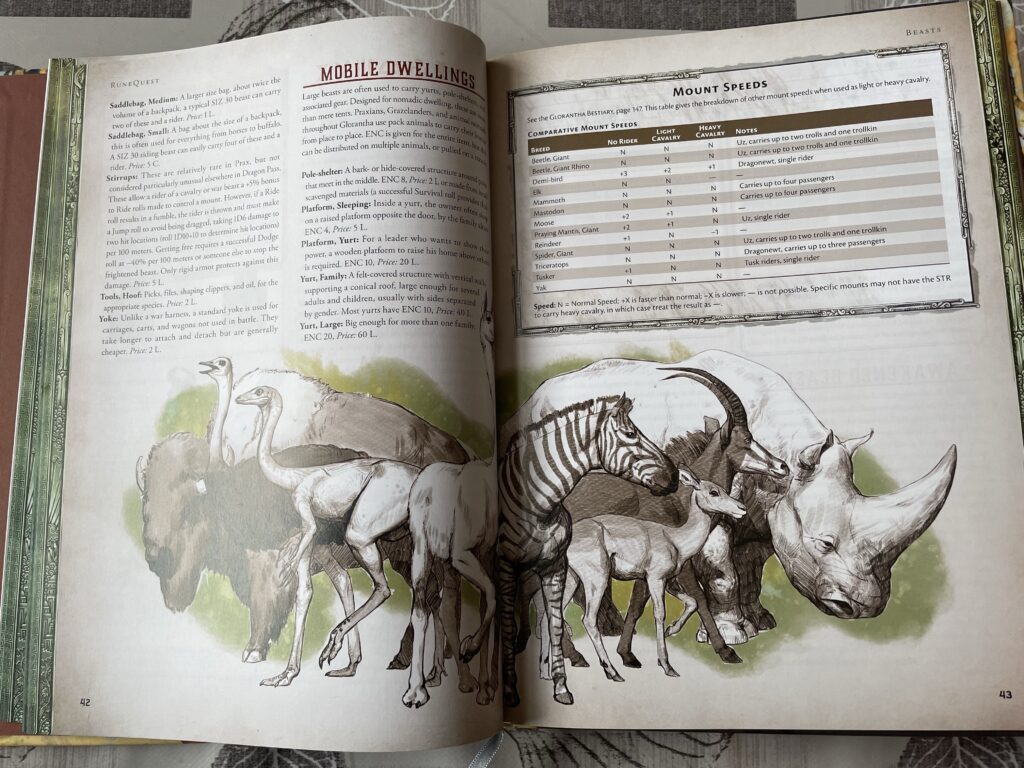
This chapter has pricing information for buying and keeping a mount, rules for training them from simple pack animals to cavalry beasts and even war mounts, and more. Our game has already made use of this chapter when all my players decided to buy animals during a short stint in Prax.
Stats for animals not found in the Glorantha Bestiary are given here, like for instance reindeers. Plus: mobile dwellings and a section on awakened beasts, which came in handy when one of my players’ character, an Ernaldan initiate, received an awakened snake as a special gift for saving the tribe.
Hirelings & Services
While the previous chapter was borderline off-topic for a book called “Weapons & Equipment”, this next chapter is definitely outside the scope of what you might have thought you’d find in here. But it is undeniably useful, especially as your adventurers gain in reputation, wealth, and power. Pretty quickly, they will have bodyguards, servants, soldiers, and other followers. This section on “Hirelings & Services” provides a lot of information for this, starting of course with these NPCs’ wages.
Once again, the text goes beyond the minimum gameable material. There is information on mercenary contracts, and the limits of their dedication to the job. There are fun things like hiring poets to insult a rival. We learn about an Issaries Herald sub-cult that has sacred protections for delivering bad news. You can hire sages and scribes for copying maps, deciphering ancient texts, or doing research into an obscure topic. This is actually very relevant to what’s going on in my campaign at the moment, as my players are trying to reach a specialist of the Empire of the Wyrms Friends in war-torn 1618 Western Esrolia.

Other types of common services for your games are magic services, such as getting an enchantment or spell matrix. The prices and benefits are great enough that you’ll probably use this section almost verbatim. However, other nearby sections in this chapter show up once again on my Grognard/Historian scale. For instance, the section on tattoos is great to contextualize this very common Gloranthan trope. The section on inns and caravanserais provides story fodder for travelling in your game. But is anybody really going to keep track of a couple Lunars here or there? Is anybody going haggle over a private room versus a common room? This is the kind of stuff everybody hand-waved back in 1990s fantasy RPGs, and I don’t know why it should be any different now in RuneQuest.
Again, the value here is almost archaeological… something that is evident with the section on funerary rites (which probably comes third in the list archaeologists’ favourite things to talk about) While it may be good to know that your adventurers need to come up with about a hundred Lunars to put that recently killed PC into a sarcophagus inside a burial mound with some offerings, the main value, at least to me, is to have a list of common burial practices in Glorantha. That tells me where my players will find angry ghosts! But frankly, if the players need to bury someone, there’s a good chance I hand-wave the price away with a roll of a Loyalty (tribe) Passion so that the community pays for it, with some bonuses if they put some of their money in the line.
Of note, one part of this chapter relates to slavery. There is a welcome sidebar that clarifies what Gloranthan slavery is (it’s a lot like Bronze and Iron Age slavery, and not at all like its later colonial form), and warns gamemasters to discuss it with their players before introducing it (or not) in their games. Good on Chaosium to have added this sidebar.
Weapons & Armour
Finally! Weapons! It’s the first half of the title, after all. I will lump the Armour chapter along with it here, since these are both straightforward combat gear for your violence-loving adventurers.
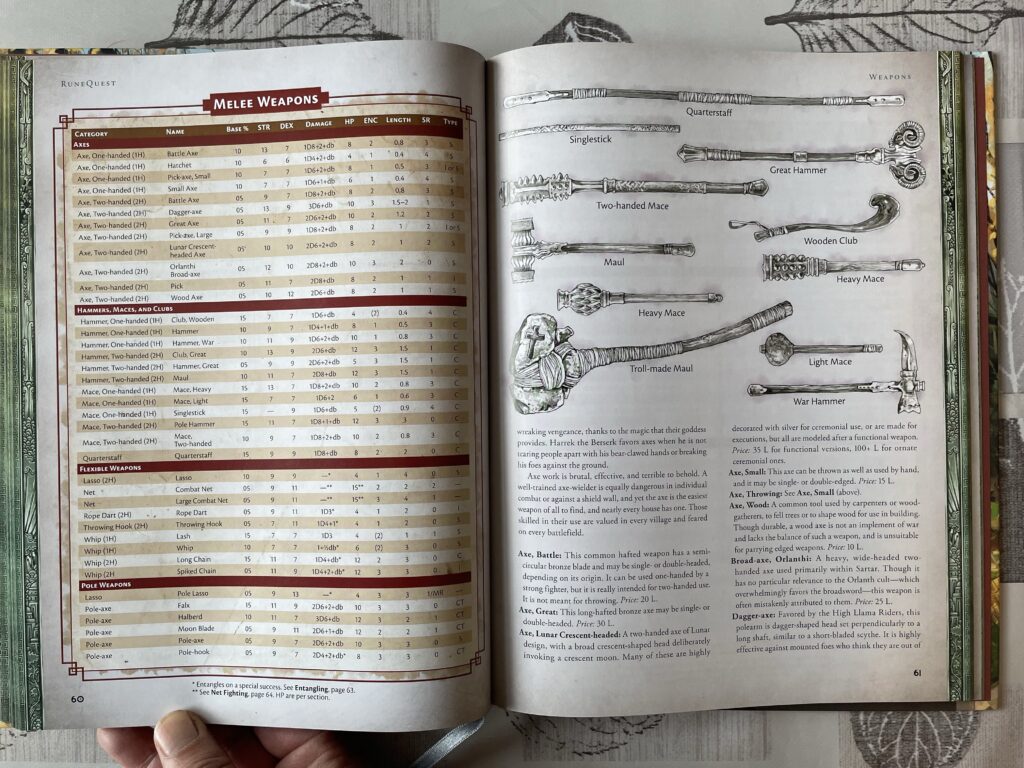
These chapters are basically expanded versions of the weapons and armour sections of the RuneQuest rulebook. They cover some of the same stuff, plus some new stuff, all with nice black and white art that shows you what it all looks like. I’m sure that min-maxing grognards will spend hours comparing tables entries to find the one weapon that gives the best results, but I can’t be bothered to do anything else than look at the prettiest drawing and just go with that. Or, even lazier, make up some random damage roll and HP for my NPCs’ weapons and wave my arms a lot.
So what we have here is more than 40 pages of old-school combat gear shopping. While it does register on the Grognard/Historian scale, it’s a pretty low ratio. Sure you learn a thing or two, like Dragonewt knapping (no, it’s not about kidnapping draconic people) or Gorakiki insect armour, but that’s pretty much it. If you thought that the rulebook had way enough weapons and armour to last your entire campaign, you might sigh at the amount of stuff presented here. Then again, the book is called “Weapons & Equipment” so don’t act surprised.
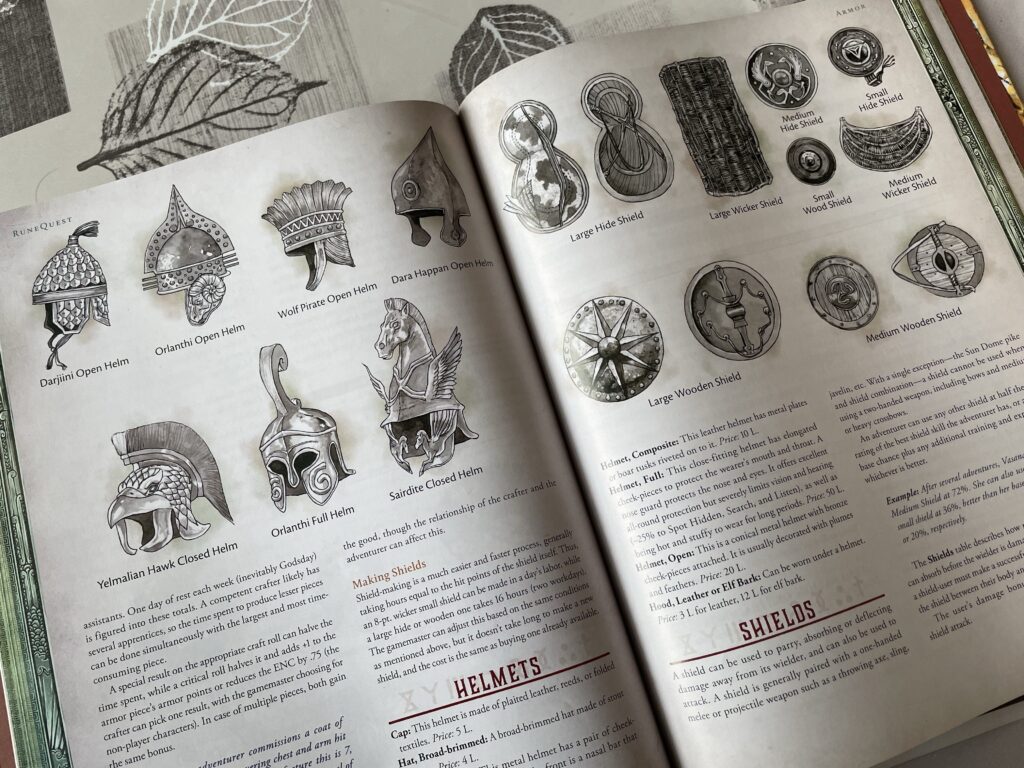
The only useful parts of these chapters as far as I’m concerned are the genuinely new mechanics. There are rules for entangling weapons (nets, lassos, etc), and rules for making new equipment (what skill to roll for what, how long it takes, how much it costs). Again, with some crafty adventurers in my party, the latter will come in handy as soon as I give my players enough downtime to work!
One last thing that may be useful to your game are the stats for non-human and beast armour… assuming you didn’t want to simply tweak the human armour accordingly and call it a day.
Travel
The next section deals with travel through Glorantha, which means that travel-related information is split between here and the section on inns and caravanserais in the Hirelings & Services chapter. The organization of the book is generally pretty good, but a few things like this sort of leak from one chapter to another, and that can lead to some confusion and page flipping.
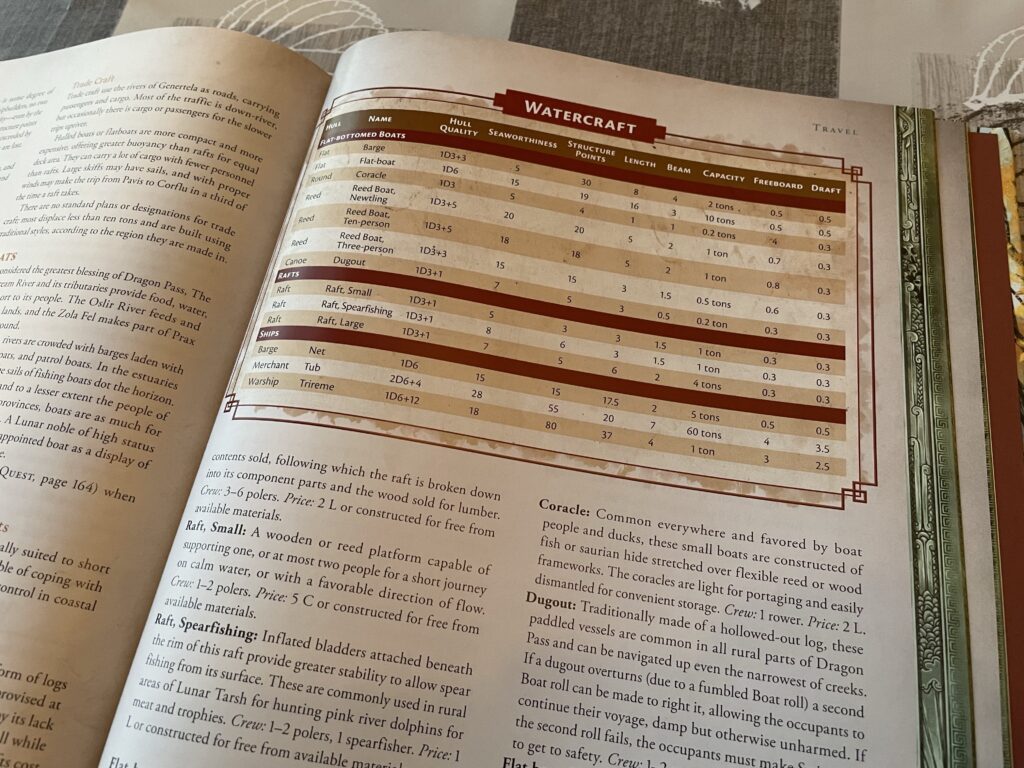
What you have here are mostly stats, prices, and duration of various modes of travel, especially boats and chariots. There are a few good bits to figure out how fast your party’s travel goes, or face-planting with your chariot, but all of it is really pretty easy to research or improvise. There’s a hint of rules for boats and watercrafts, but the text mostly references the yet-to-be-published RuneQuest Gamemaster Sourcebook in which, we are promised, will be full rules for owning, maintaining, and waging combat on a ship.
Overall, I don’t personally find this a very useful chapter.
Dwellings
The chapter on land and homes is quite fun. Not only does it again give us a glimpse of daily life in Glorantha, it also has some basic mechanics for building and upgrading your adventurers’ households. Of course, it’s not as fun as “proper” base-building mechanics like those found in, say, Forbidden Lands, Mutant Year Zero, or Vaesen (yes, I’m a Free League fan too), since those are truly integrated into the gameplay… but it’s still sort of fun to use for flavour. Plus, there are random tables for stuff you might find in a piece of land your adventurer was just granted, and I love me some random tables almost as much as I love maps. Again, this is something we’ve used once in our game, and I’m hoping to do a bit more with it.
The downside is that RuneQuest here continues the tradition of gameplay economics that yield net losses on average in the hopes that it motivates players to take risks and go on adventures. This isn’t surprising for an old-school game that was created around the same time as, say, Traveller, which also puts the PCs in debt to send them into a life of adventuring… but I’m wondering if this will actually put off modern players.
As per the rulebook, a noble with five hides of lands barely covers their Standard of Living on a successful income roll, and actually loses money when you add cult tithing and other expenses. The Fortifications and Land Improvements presented in Weapons & Equipment are therefore a tricky proposition: they cost money to maintain in exchange for various bonuses whose effects are hard to quantify. Some give income roll bonuses while others give Harvest roll bonuses (a roll that may give you income roll bonuses!) Some give Reputation bonuses, and others don’t give you anything mechanically tangible. Several improvements require tracking each hide of land independently, as they get different bonuses… ok, now choose one!
I haven’t tested this yet, but I get the impression that narrative-driven players will just pick what sounds cool and feel like being punished when they lose money. Meanwhile, mechanics-driven players will be stuck for hours trying to unravel all these bonuses. This possibly needs a hefty dose of expectations management and oversight from the gamemaster.
I think these rules might be desirable only if you own a large property anyway (eight hides or more). Maybe that’s the point, but it means that you’ll have to grant your players a whole bunch of land before you can use this chapter. Thankfully, there’s a section to help you manage these land grants, which I have already used in my games. I’m trying to break away from the old gameplay trope of keeping the PCs poor, and increasingly giving free stuff to my players.
Training
The next chapter expands on the “Between Adventures” chapter of the rulebook, especially when it comes to finding someone to train your adventurer. This could have been part of the Hirelings & Services chapter, but has been set aside in its own chapter, possibly because it would be used between adventures rather than during them.
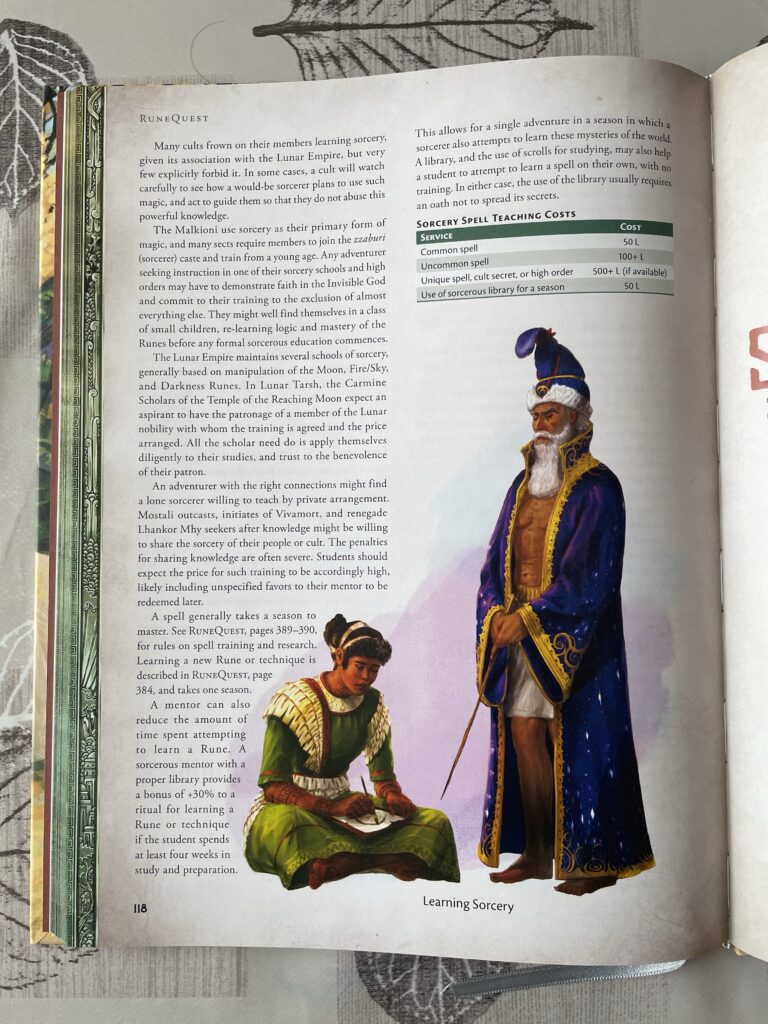
Once again, the long-promised RuneQuest Gamemaster Sourcebook gets a name drop (for rules and information about Gloranthan guilds), and the Cults of Glorantha (sadly since renamed as Cults of RuneQuest) also gets a mention (for the Etyries’ Exchange Spells Rune spell, which you can already find in the Red Book of Magic anyway).
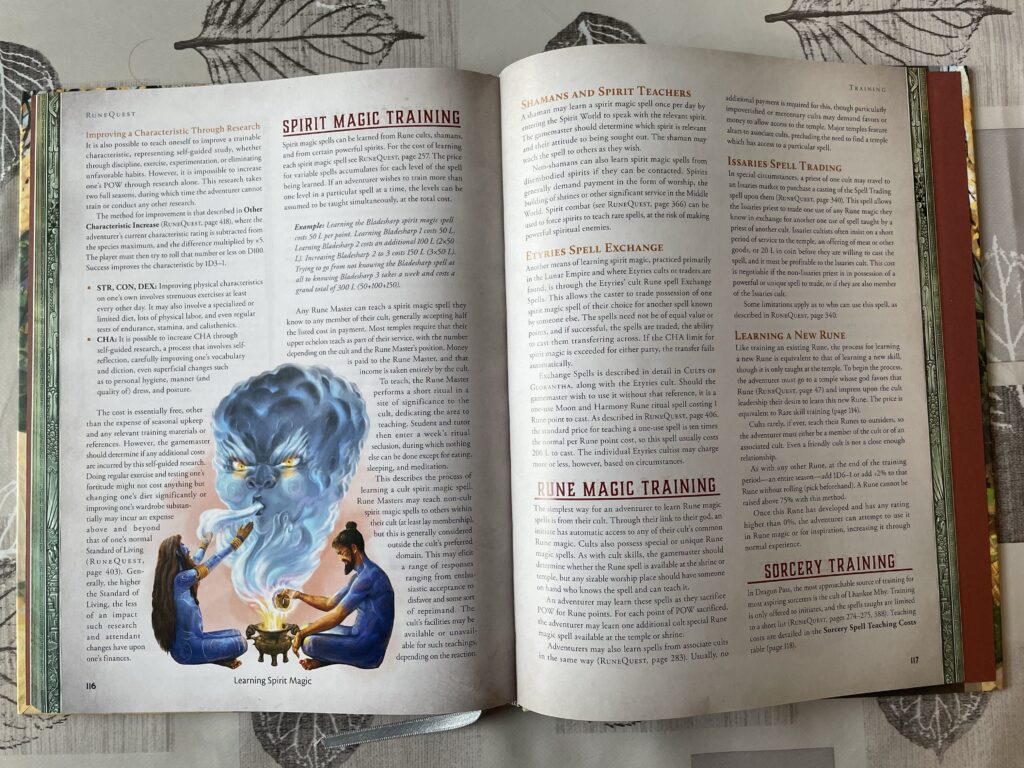
This section may have some better explanation or context for things related to characteristic, skill, and magic training, but I didn’t see anything really new or compelling compared to the RuneQuest rulebook. And it still has this outdated (and possibly problematic in my opinion) view that INT it can’t be improved except by magical means.
The only valuable bit as far as I’m concerned was a small paragraph suggesting that adventurers change their occupation for a season (if appropriate given their story) to get multiple experience rolls, rather than just the one roll in the skill they’ve been training. For instance, an adventurer working on a farm to learn Animal Lore might also get experience checks in, say, Herd, and Farm as part of their four seasonal occupation skill experience checks, as opposed to whatever usual occupation they have.
Exotic Items
This last chapter of Weapons & Equipments looks at Exotic Items. The first half is a reiteration of the Gamemaster Adventures’ Appendix on magic crystals. I didn’t notice anything new there. The second half deals with enchanted items and presents a short but nice list of such objects.

I can see myself using this section a few times over a few adventures in order to introduce fun magic items into the game. I especially like the seemingly-useless items, such as the metal spoon that makes bland food taste good… However, dedicated sourcebooks like Plunder or Treasures of Glorantha are of course better for this kind of thing.
Conclusion
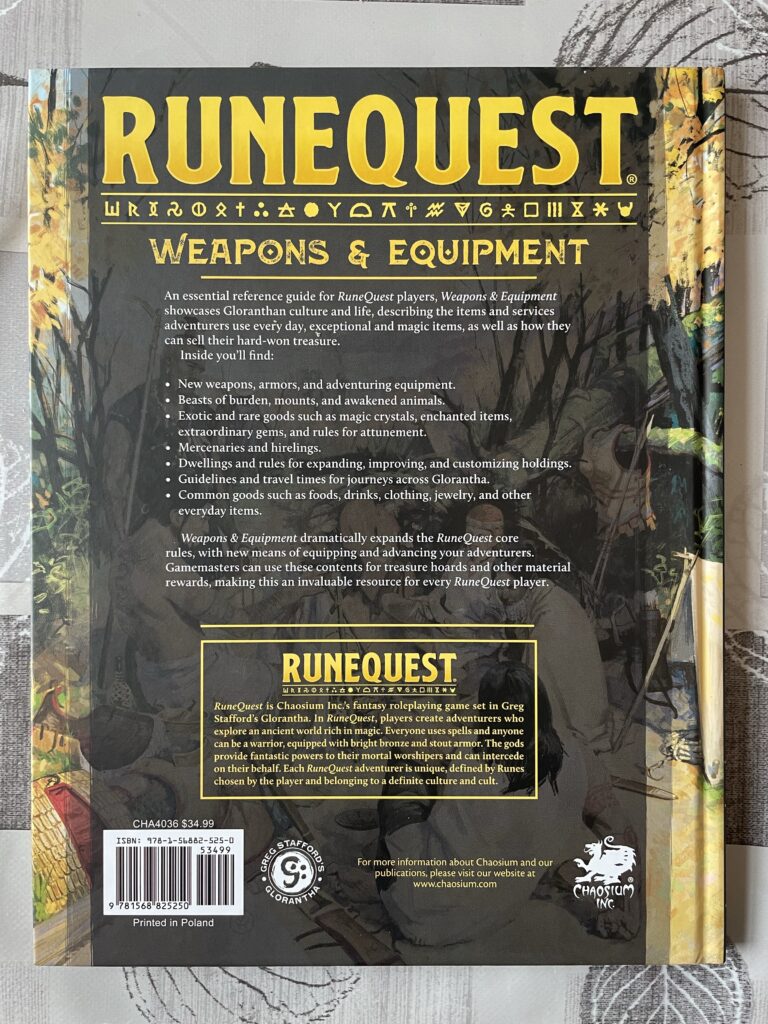
And that’s RuneQuest Weapons & Equipment!
As I said in the early parts of the review, this is one tough book to judge. On the one hand, it’s a great looking book that contains many insightful looks at the daily life of Gloranthan people, with quite a few useful optional rules and object references. On the other hand, a lot of its contents encourages old-school gameplay and bean counting, there is repetition of material you probably already own, and references to stuff that, more than year since the PDF came out, still haven’t been released.
The value you’ll get from this book will vary a lot based on your style of play and the themes of your campaign. Like me, you’ll probably find sections that are useful and sections that are useless… the question is how much of each?
Personally speaking, the “Weapons & Equipment” part of the “Weapons & Equipment” book is actually the least interesting. Everything else is infinitely more useful than lists of adventuring gear and tables of weapons. I’m definitely not alone in this, since the announcement of the book was generally received by groans and shrugs in my gaming circles. But this isn’t the book people thought it was. This is the book that lets me populate my Glorantha with the flavourful bits of the ancient world. This is the book I reach for when my players want to hire someone, craft a piece of armour, or buy some new mounts. This is the book that gives me the gaming material I need when I reward the adventurers with hides of land or fancy swords. It’s not a perfect book but it’s quite useful and very pretty, and that’s what we want from our RPG books, isn’t it?


